The Night of the Generals (1967)
Directed by: Anatole Litvak
Written by: Hans Hellmut Kirst, Joseph Kessel, Paul Dehn
Starring: Donald Pleasence, Omar Sharif, Peter O'Toole, Tom Courtenay
UK/USA/France
AVAILABLE ON BLU-RAY: NOW, from EUREKA ENTERTAINMENT
RUNNING TIME: 148 mins
REVIEWED BY: Dr Lenera, Official HCF Critic
The murder of a prostitute in German-occupied Warsaw in 1942 causes Major Grau to start an investigation, as the victim was also a German agent. An eyewitness saw a German General leaving the building after hearing a scream, and evidence soon points to the killer being one of three people: General von Seidlitz-Gabler; General Kahlenberge, his chief of staff; or General Tanz. However, Grau’s investigation is cut short by his promotion and transfer to Paris at the instigation of these officers. The case is closed – for now. But in Paris in 1944, as a plot to kill Hitler and thereby end the war is being hatched, this quartet is reunited.…
We probably all agree that Nazis make great villains, probably in part because they really existed and many of them were just as nasty as anything a screen writer can dream up. But tell me, what’s scarier than a Nazi? How about a Nazi that’s also a serial killer? That’s the central gimmick of The Night Of The Generals, which in a manner more familiar to novels than films interweaves a fictional story and fictional characters with real historical events. I must admit, I balked somewhat at watching and reviewing a movie that was only three minutes shorter than the 148 min-long film I watched and reviewed two days before. That was I Spit On Your Grave: Deja Vu, which in no way needed to be just under two and a half hours long. But it did seem like this film’s length would be more justifiable, what with its sprawling story that spans twenty-three years. In fact there is a bit of none-too relevant material in it, like a romance which only links with the central narrative towards the end and which even then could have been easily removed. In fact Tom Courtney’s whole character seems totally irrelevant until three fifths of the way through. And I would imagine that many first-time viewers today will have trouble being convinced by a film in which all the characters are German or French yet where all the cast members speak a variety of English accents or are dubbed into English. But the film does do well in adopting a sober, even cerebral approach to its potentially exploitative subject matter and, while the terrific cast is erratic, it may contain the most entertaining performance of Peter O’ Toole’s career – you probably won’t be able to take your eyes off him when he’s onscreen. Whether it’s actually a good piece of acting could be debated, but I loved it. And in fact, come to think of it, I don’t think I’ve ever liked Omar Sharif as much as I did in this movie either.
The screenplay by Joseph Kessel and Paul Dehn [along with un-credited contributions by Gore Vidal and Robert Anderson] was loosely based on the beginning [yes, just the beginning!] of the novel of the same name by German author Hans Hellmut Kirst, though the writing credits also include the line,“based on an incident written by James Hadley Chase”. Because Peter O’Toole and Omar Sharif were being held to contracts signed several years earlier when they were less famous, they both had to accept smaller fees than they were now used to. Sharif, who claimed the film was against his “political and moral beliefs” , was only in it so he could work with his Lawrence Of Arabia co-star O’Toole again. This was the first major American production company allowed to film in Communist Poland, though permission was only granted after one character was changed from an East German General to a neo-Nazi leader in West Germany after the war. O’Toole was already prone to the booze, and turned up totally drunk for a scene, yet performed it perfectly before getting back to his alcoholic condition, unable to even stand up. As for Sharif, while shooting in Warsaw in the winter, he took a break and walked into a café to warm up, still wearing his uniform costume. This upset the café’s patrons and he was refused service, despite his attempts at explaining he was an actor making a movie, and that the war had been over for almost twenty-two years. Its sexual content meant that this film was one of the last to run into heavy censorship trouble in the US before the abolition of the Production Code Administration and its replacement with the voluntary ratings system by the Motion Picture Association of America in 1968, though it wasn’t cut there in the end. In the UK though, it was heavily edited for an ‘A’ [PG] certificate, removing virtually all adult content including dialogue about the murders and the victims being whores. It was a major flop.
The opening titles in a way set a misleading tone, with fetishistic close-ups of parts of a Nazi General’s uniform along with a woman’s legs in stockings, an eye, a hand clasping itself and a knife being pulled out. This is, of course the murderer and probably a victim too, but it does suggest that we’re going to watch a very sleazy, kinky effort. In fact it’s very restrained and not at all sensationalist [though I doubt it would have been that way if made just a few years later], the two murders not shown, nor indeed the bodies, though through suggestive shots and dialogue we get the impression that the murdered mutilated his victims in a sexual fashion with his knife. A witness to the first killing sees somebody leave the prostitute victim’s room wearing very conspicuous uniform, but is cagey about talking because we’re in German-occupied Poland and accusing a German officer of something like murder can result in no less than death. However, he does tell Abwehr [German Intelligence Military Service] Major Grau, and Grau is inclined to believe him, because who on earth would tell such a dangerous lie? Grau is a great character, his idealism and dogged determination so great that you forget he’s a Nazi, He’s not even politically minded, only showing an opinion when he criticises General Tanz’s destruction of a section of Warsaw. I can’t imagine that few ever think of Sharif as a great actor, and he was clearly more interested in playing bridge and spending money for much of his life, but he could deliver the goods when he felt like it, and he certainly does here, despite his poor try at a German accent. He commands the screen and seems to be really enjoying the part even if he didn’t like the actual film.
The film begins to get a little disjointed with cuts to 1965 and Interpol Inspector Morand investigating – surprise surprise – the murder of a prostitute. I tend to love films that move around in time, but here the ‘almost present day’ scenes are too brief to have much of an effect until the final act, and I wonder if placing some of these right at the beginning would have been better. On the other hand though we do get some interesting transitions where narration becomes dialogue and a museum becomes a Nazi headquarters in a jump cut. Back in 1942 and the three suspects are quickly identified. 007 fans will love the sight of two Blofelds Donald Pleasance and Charles Gray sharing many scenes together [and hardcore Bond buffs will recognise the voice of Robert Rietty doing dubbing duties], though of course when O’ Toole is on screen your eyes turn to him. I would imagine his performance has been criticised as being hammy what with all his facial ticks, and just check out that walk he does [I’d have been imitating it in the school playground if I’d seen this film as a kid], but to be fair he did have a tendency to ham it up when he may have felt the material was beneath him i.e. Supergirl. And his character here is rather bonkers, so obsessed with everything being done on time and cleanliness that he’ll express displeasure at his bath water being just one degree less than it should be, and sack a chauffeur for having one dirty fingernail. Tanz’s brand of villainy is summed up when he’s soon to drive a load of people out of their homes and set fire to their abodes, but before that throws some food to some street kids so he can “win their confidence”, and even orders his subordinates to always carry bread and food around with them so they can do the same.
Said fire sequence is probably the film’s action highlight, very convincing and even dangerous-looking [well, this was made in the days when all movie explosions had to be real], though The Night Of The Generals isn’t trying at all to be an action film. Instead, it’s going for a lower-key, much slower approach, and that’s fine for some of the time, though the introduction of a love story between General von Seidlitz-Gabler’s [one of the suspects] daughter Ulrike and Corporal Kurt Hartmann [who to the astonishment of others doesn’t want promotion] is frustrating because you just want to get back to the more interesting stuff, and we don’t even see how they first met [possibly a casualty of the cutting room, as with material pertaining to how their relationship ended?]. All we get is a character narrating how women like Hartmann, and we then cut to Hartmann and Ulrike in bed. But when we move forward to 1944 things get rather good. Grau is still after his man and von Seidlitz-Gabler, Kahlenberge and Tanz are all still around, while Hartmann becomes Tanz’s new chauffeur, and we meet Inspector Morand as a younger person. We get a bit of red herring stuff about blood on a uniform that could also be lipstick, then the murderer quickly becomes obvious, but that means we get a hell of a lot of great drawn-out suspense as we follow him around and are waiting to see what will set him off – which turns out to be a self-portrait of Vincent Van Gogh! There’s some attempt at insight into the mind of a psychopath here, things are heating up almost unbearably – and then the film takes a detour concerning the real-life plot to kill Adolph Hitler, before one genuine surprise as to the fate of one of the characters, and a downbeat 1965 conclusion. You don’t get a big climax here, just the logical resolution of a solid story, though the plot could have been concluded with little alteration in 1944, and see if you can work out why on earth somebody’s request for a gun is agreed to – I couldn’t. Of course the biggest pitfall of this kind of final act tends to be the aging makeup that performers sport. Here, it’s a mixed but evenly balanced bag. For example Tom Courtney looks fine, but Charles Gray just appears laughable.
While even I was able to notice that some of the weapons weren’t exactly of ‘40s vintage, and there’s a bar singing scene that’s very ‘60s right down to many of the costumes, the historical side of things is often quite accurate. The try at killing Hitler is depicted as reports have told us, and if you’ve seen Valkyrie, compare the seriously damaged-looking General Von Stauffenburg in this film with the version played by Tom Cruise. Hitler isn’t even shown, though Christopher Plummer gets a pointless walk-on role as Erwin Rommell. Politically the film keeps its distance, though I did love the scenes between the French Morand and the German Grau. Morand probably hates Grau but knows he can help him, while Grau definitely knows that Morand is involved with the French resistance but is prepared to go so far as to release three resistance fighters to get information. Their dinner scene together, with much appreciation of wine, is a gem, Sharif and Phillipe Noiret really sharing some chemistry, and you get a great depiction of two people on opposite sides who share a common need for justice to be served and who therefore form something of a bond. It’s also interesting to see stalwarts of British war films like Harry Andrews and John Gregson dressing up as Germans, but the whole language thing in this film doesn’t really come off. Yes, it used to be common in films to have every character speak English regardless of their nationality, but here you also sometimes get people speaking German or Italian too.
Director Anatole Litvak’s character staging is often very static, with people sometimes virtually lined up right in front of you. The gray-dominated nature of the exterior footage [even the skies are gray] is certainly appropriate if not visually very pleasing, while interiors are often sumptuous. Maurice Jarre’s score has been criticised as being out of place. While sometimes recorded very loud, I’m not sure I’d agree. His main title piece introduces his three main musical devices very well – a usually upbeat march for the Nazis often distorted in the score proper, a jaunty waltz which to me was enjoyably ironic but which also worked well slowed down as a ‘love’ theme, and a series of dissonant, evil-sounding chord progressions. For me, it’s a strong feature in a film that’s undoubtedly rather unwieldy and which makes some odd decisions, but is still frequently compelling and fascinating.
Rating: 









Eureka’s Blu-ray release of The Night Of The Generals looks fine, if not quite spectacular. The unappealing dominance of gray is certainly not Eureka’s fault, and the bits of colour [often red] popping out look great. Detail is very strong and grain evenly managed. I will say that skin tones sometimes appear a bit pallid, but it’s not overly detrimental to the release. Eureka have dispensed with the isolated score on the Twilight Time Region ‘A’ release and instead included an audio commentary track. Writer and lover of the film Scott Harrison takes a while to get started, and does tend to miss pronounce names and get titles wrong, but I rather liked the unrehearsed nature of his track even with its frequent digressions, and once he gets most of the biographies out of the way he seems to step up a notch. He doesn’t talk much about production, and does tend to tell you who’s just appeared on screen, but offers a lot of insight and observation, and is especially good at discussing the historical background, not all of which might be clear to those watching the film who aren’t boned up on World War 2. We’re on the same page regarding the 1965 scenes – I’m glad they’re there, but they could have been dispensed with. You might have a higher regard for the film after listening to this track.
They don’t really make ’em like this any more. This is something of an oddity when viewed today, but a worthwhile one despite its flaws. Recommended.
SPECIAL FEATURES
*1080p presentation on Blu-ray, taken from a stunning 4K restoration
*Uncompressed LPCM audio (original mono presentation)
*Optional English subtitles
*Brand new and exclusive Audio Commentary by author Scott Harrison
*Original Theatrical Trailer
*Limited Edition Collector’s booklet featuring new writing by author Scott Harrison

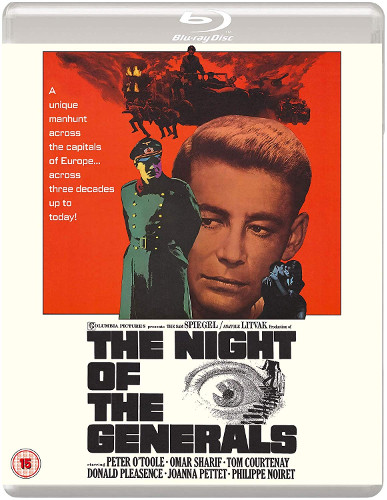
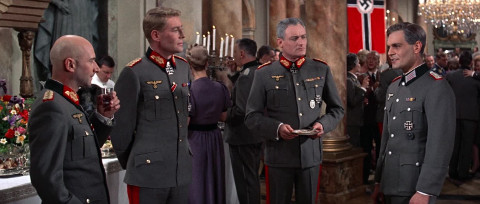
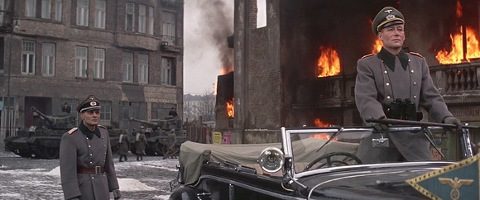

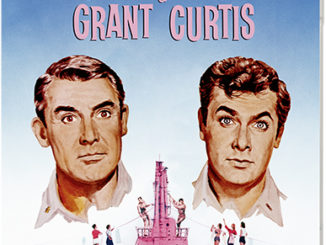
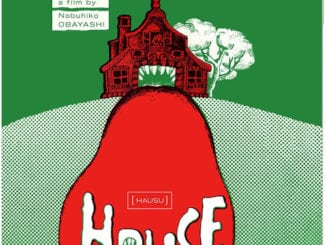
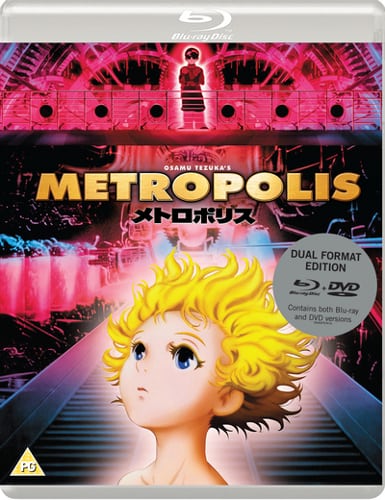
Be the first to comment